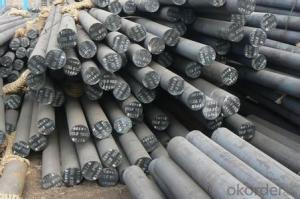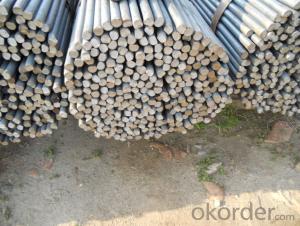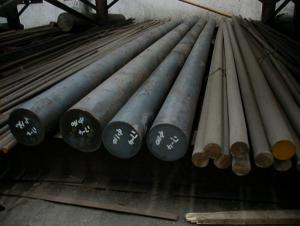High Quality Steel Round Bar Q235, A36, SS400
- Loading Port:
- Lianyungang
- Payment Terms:
- TT OR LC
- Min Order Qty:
- 25 m.t.
- Supply Capability:
- 200000 m.t./month
OKorder Service Pledge
OKorder Financial Service
You Might Also Like
Specifications of High Quality Steel Round Bar Q235, A36, SS400
1. Grade: GB, JIS, ASTM, EN
2. Grade: Q235, SS400, A36, S235JR
3. Diameter and mass: As below
Diameter | Mass | Diameter | Mass | Diameter | Mass |
(mm) | (kg/m) | (mm) | (kg/m) | (mm) | (kg/m) |
6 | 0.22 | 22 | 2.98 | 53 | 17.30 |
7 | 0.30 | 24 | 3.55 | 56 | 19.30 |
8 | 0.40 | 25 | 3.85 | 60 | 22.20 |
9 | 0.50 | 26 | 4.17 | 63 | 24.50 |
10 | 0.62 | 28 | 4.83 | 65 | 26.00 |
11 | 0.75 | 30 | 5.55 | 70 | 30.20 |
12 | 0.89 | 32 | 6.31 | 75 | 34.70 |
13 | 1.04 | 34 | 7.13 | 80 | 39.50 |
14 | 1.21 | 36 | 7.99 | 85 | 44.50 |
15 | 1.39 | 38 | 8.90 | 90 | 49.90 |
16 | 1.58 | 40 | 9.86 | 95 | 55.60 |
17 | 1.78 | 42 | 10.90 | 100 | 61.70 |
18 | 2.00 | 45 | 12.50 | 120 | 88.85 |
19 | 2.23 | 48 | 14.20 | 140 | 120.93 |
20 | 2.47 | 50 | 15.40 | 150 | 138.82 |
4. Material: Mild Steel
5. Heat treatment of high quality steel:
Fire: Isothermal annealing temperature is 800 ~ 880 °C, with 10 ~ 20 °C, the furnace cooling to about 600 °C, hardness above HB269.
Preheat temperature: 730-730 °C
Quenching temperature: 1190-1210 °C
Tempering temperature: 540-595 °C
Cold drawn, hardness 285 HBS
Cold drawn after annealing condition, hardness 277 HBS
Quenching methods: oil quenching, air cooling or salt bath quenching
Usage and Applications of High Quality Steel Round Bar Q235, A36, SS400
1) Suitable for making various strong cutting tool abrasion resistance, impact resistance.
2) Used to produce all kinds of high hard and super hard saw blade, drill, tap, broach, gear hob and various kinds of milling cutter.
3) Used for advanced punching die, screw die, and the toughness and complicated shape of the punch, etc.
4) Is used for cold forging die and drawing mode, etc.
5) Recommended watchcase factory, screw factory and other cold stamping products industry use.
Packaging & Delivery of High Quality Steel Round Bar Q235, A36, SS400
Packaging Detail: All goods are packed in bundle with steel strips and shipped by break bulk vessel or container (depend on target market and different ports)
Delivery Detail: 45 days
Trade terms: FOB, CFR, CIF
MOQ: 25 tons per specification; we can negotiate the quantity if the specification is normal or we have stock of one specification.
Weight: The price invoicing on theoretical weight basis or actual weight basis depends on customer’s request.
Shipment: The shipment of bulk break or container is depends on customer’s request and the situation of the port of destination.
Documents given: Full set of original clean on board bill of lading; Original signed commercial invoice; Original packing list; Policy of insurance; Certificate of origin and what the target market needs.
Production Flow of High Quality Steel Round Bar Q235, A36, SS400
The common processes are preheated forging quenching, dual refinement solution process, cooling quenching and isothermal quenching. We use heat treatment for dual refinement solution process. The main measures process is high temperature solution and refinement cycle. High temperature solution can improve the carbide morphology and particle size. The aim is to make the loop refinement ultrafine austenite grains.
- Q:Can steel round bars be bent or formed into different shapes?
- Steel round bars have the capability to undergo bending or shaping into diverse forms. Steel possesses a remarkably malleable nature, signifying that it can be easily molded sans any fracturing or cracking. To achieve the bending or shaping of steel round bars, multiple techniques can be employed, including the application of heat to enhance pliability or the utilization of specialized tools like hydraulic benders or presses. The extent to which steel round bars can be bent or shaped is contingent upon factors such as steel thickness, composition, and the desired specific form or angle. In a broader sense, steel round bars provide a versatile choice for fabricating a wide array of shapes and structures that are indispensable in various industries, encompassing construction, automotive, and manufacturing.
- Q:What are the factors affecting the price of steel round bars?
- There are several factors that can affect the price of steel round bars. Some of the key factors include the cost of raw materials used in steel production, such as iron ore and coal. Additionally, factors such as global supply and demand, market competition, and economic conditions can also influence the price of steel round bars. Other factors like transportation costs, energy prices, and government regulations can also play a role in determining the final price of steel round bars.
- Q:Can steel round bars be used for making steering linkages?
- Yes, steel round bars can be used for making steering linkages. Steel round bars are commonly used in various applications, including automotive and mechanical engineering, due to their high strength, durability, and resistance to wear and tear. Steering linkages are critical components in a vehicle's steering system, responsible for transmitting steering input from the steering wheel to the wheels. The use of steel round bars provides the necessary strength and rigidity required to ensure efficient and reliable steering performance. However, it is important to consider other factors such as the specific design requirements, weight considerations, and the desired level of flexibility or torsional properties when selecting the appropriate type and size of steel round bar for steering linkages.
- Q:What are the advantages of using wear-resistant steel round bars?
- The advantages of using wear-resistant steel round bars are that they provide increased durability, extended service life, and enhanced performance in high-wear applications. These bars are specifically designed to withstand abrasion, impact, and other forms of wear, making them ideal for industries such as mining, construction, and manufacturing. By using wear-resistant steel round bars, companies can reduce maintenance costs, minimize downtime, and improve overall operational efficiency.
- Q:How do you calculate the moment of inertia of a steel round bar?
- In order to determine the moment of inertia for a steel round bar, one must possess knowledge of the bar's dimensions and properties. The moment of inertia serves as a gauge for an object's resistance to rotational changes. The formula utilized to compute the moment of inertia for a solid cylindrical item, such as a round bar, is as follows: I = (π/4) * D^4, where I signifies the moment of inertia and D symbolizes the bar's diameter. Initially, ascertain the diameter of the steel round bar by means of a caliper or ruler. It is essential to measure the diameter at its broadest point, typically found at the center. Subsequently, input the measured diameter into the formula and calculate the moment of inertia. It is crucial to use the correct units for diameter, such as inches or millimeters, to maintain consistency with the formula. For instance, let's assume the diameter of the steel round bar measures 2 inches. By substituting this value into the formula: I = (π/4) * (2 inches)^4 = (π/4) * 16 inches^4 = 4π inches^4. Therefore, the moment of inertia for the steel round bar with a diameter of 2 inches equals 4π inches^4. It is imperative to recognize that this formula assumes a solid cylindrical shape devoid of any alterations in diameter or hollow sections. If the round bar presents variations in diameter or is hollow, the moment of inertia calculation becomes more intricate and necessitates additional considerations.
- Q:How are steel round bars used in the construction of transmission towers?
- Steel round bars are commonly used in the construction of transmission towers due to their strength, durability, and ease of fabrication. These bars are typically made from high-strength carbon steel and are available in various diameters to suit different structural requirements. In the construction of transmission towers, steel round bars are primarily used as the main structural elements. They form the vertical and diagonal members that provide strength and stability to the tower. The bars are typically connected together using various methods like welding or bolted connections to form the lattice structure of the tower. The round shape of the bars allows for uniform distribution of forces, making them ideal for withstanding the loads and stresses that transmission towers experience. These loads include the weight of the tower itself, the electrical conductors, and environmental factors like wind, ice, and seismic forces. Additionally, steel round bars offer excellent corrosion resistance, which is crucial for transmission towers that are often exposed to harsh weather conditions. This resistance helps to prolong the lifespan of the tower and ensures the safety and reliability of the transmission lines. Furthermore, steel round bars can be easily fabricated and customized according to the specific design requirements of the transmission tower. They can be cut, bent, and shaped into the desired dimensions, allowing for flexibility in tower design and construction. Overall, steel round bars play a vital role in the construction of transmission towers by providing strength, durability, and resistance to corrosion. Their versatility and ability to withstand various loads make them an essential component in ensuring the safe and reliable transmission of electricity.
- Q:What are the different types of steel round bar alloys for improved toughness and wear resistance?
- There are several different types of steel round bar alloys that are specifically designed to offer improved toughness and wear resistance. These alloys are often used in applications where strength and durability are essential. Some of the commonly used alloys include: 1. Alloy Steel: Alloy steel round bars are made by adding different alloying elements such as chromium, nickel, molybdenum, or vanadium to enhance their mechanical properties. These alloys offer increased strength, toughness, and wear resistance. 2. Stainless Steel: Stainless steel round bars are corrosion-resistant alloys that contain a minimum of 10.5% chromium. They have excellent toughness, high strength, and superior wear resistance. Stainless steel round bars are widely used in industries such as aerospace, automotive, and construction. 3. Tool Steel: Tool steel round bars are specifically designed for applications where high wear resistance and toughness are crucial. These alloys are commonly used in the manufacturing of cutting tools, dies, and molds. Tool steel alloys often contain elements such as tungsten, vanadium, or molybdenum to improve their hardness and wear resistance. 4. Carbon Steel: Carbon steel round bars are widely used due to their high strength and toughness. These alloys contain varying amounts of carbon and are known for their excellent wear resistance. Carbon steel round bars find applications in industries such as manufacturing, construction, and automotive. 5. Bearing Steel: Bearing steel round bars are designed to withstand high stress and provide excellent wear resistance. These alloys are commonly used in the production of ball bearings, roller bearings, and other high-performance bearing components. Bearing steel alloys typically contain elements such as chromium, silicon, and manganese to enhance their mechanical properties. In conclusion, there are various types of steel round bar alloys available that offer improved toughness and wear resistance. The selection of the most suitable alloy depends on the specific application requirements and desired mechanical properties.
- Q:How do steel round bars compare to plastic round bars?
- When comparing steel round bars and plastic round bars, it is important to note several key differences that impact their performance and suitability for different applications. Strength and durability play a significant role in determining the ideal choice for specific applications. Steel round bars are renowned for their exceptional strength and durability, making them perfect for applications that require high load-bearing capacity. They can withstand heavy loads without deforming or breaking. Conversely, plastic round bars are generally less strong and durable, making them more suitable for lighter applications where strength is not the primary concern. Weight is another factor to consider. Steel round bars are considerably heavier than plastic round bars due to differences in material density. This can be advantageous in applications where additional weight is desired for stability or balance. Conversely, plastic round bars are lighter and can offer benefits in weight reduction, which is particularly important in industries like aerospace or automotive. Corrosion resistance is a crucial consideration, especially in harsh environments or areas exposed to moisture. Steel round bars, particularly those made from stainless steel, are known for their excellent corrosion resistance. This makes them suitable for outdoor or corrosive environments. Conversely, plastic round bars are generally more susceptible to degradation caused by UV radiation, chemicals, or extreme temperatures. Consequently, they may not be as suitable for outdoor or corrosive environments. Versatility is yet another aspect to evaluate. Steel round bars offer a wide range of options in terms of size, shape, and grade. They can be machined, welded, bent, or shaped to suit various applications. While plastic round bars also come in different shapes and sizes, their versatility is somewhat limited compared to steel. They may not be as easily machined or welded, and their performance can be affected by temperature fluctuations. Cost is a significant factor to consider. Steel round bars are generally more expensive due to the higher costs associated with raw materials and manufacturing processes. On the other hand, plastic round bars are more affordable and can provide cost savings in certain applications. In conclusion, steel round bars offer superior strength, durability, and corrosion resistance, making them ideal for heavy-duty applications. Plastic round bars, on the other hand, are lighter, more affordable, and can be advantageous in applications where weight reduction is important. Ultimately, the choice between steel and plastic round bars depends on the specific requirements of the application and the trade-offs between strength, weight, cost, and corrosion resistance.
- Q:Are steel round bars available in different colors?
- Steel round bars are generally found in a metallic grey hue, which is the inherent color of the steel material. Nevertheless, alternative colors of steel round bars can be obtained by utilizing different techniques like powder coating or painting. Through these procedures, a layer of paint or powder is applied to the surface of the steel, offering a diverse array of colors. This facilitates customization and aesthetic considerations, particularly in applications where the visual aspect of the steel is significant. It should be noted that the range of available colors may differ depending on the supplier or manufacturer.
- Q:What are the different types of steel used to make round bars?
- There are several different types of steel that are commonly used to make round bars. The specific type of steel used depends on the desired properties and applications of the round bar. One common type of steel used for round bars is carbon steel. Carbon steel is known for its high strength and durability. It is often used in applications that require a strong and rigid material, such as construction, machinery, and automotive components. Another type of steel used for round bars is stainless steel. Stainless steel is known for its corrosion resistance and ability to withstand high temperatures. It is commonly used in applications that require resistance to moisture, chemicals, and heat, such as food processing equipment, medical devices, and architectural structures. Alloy steel is another type of steel used for round bars. Alloy steel is made by mixing iron with other elements, such as manganese, chromium, and nickel, to enhance its properties. It offers improved strength, hardness, and resistance to wear and tear. Alloy steel round bars are often used in applications that require high strength and toughness, such as aerospace components, automotive parts, and machinery. Tool steel is a type of steel that is specifically designed for making tools and dies. It is known for its high hardness, wear resistance, and ability to hold a sharp cutting edge. Tool steel round bars are commonly used in applications that require cutting, shaping, and forming, such as drills, punches, and molds. Overall, the choice of steel used to make round bars depends on the specific requirements of the application, including factors such as strength, corrosion resistance, heat resistance, and wear resistance.
1. Manufacturer Overview |
|
|---|---|
| Location | |
| Year Established | |
| Annual Output Value | |
| Main Markets | |
| Company Certifications | |
2. Manufacturer Certificates |
|
|---|---|
| a) Certification Name | |
| Range | |
| Reference | |
| Validity Period | |
3. Manufacturer Capability |
|
|---|---|
| a)Trade Capacity | |
| Nearest Port | |
| Export Percentage | |
| No.of Employees in Trade Department | |
| Language Spoken: | |
| b)Factory Information | |
| Factory Size: | |
| No. of Production Lines | |
| Contract Manufacturing | |
| Product Price Range | |
Send your message to us
High Quality Steel Round Bar Q235, A36, SS400
- Loading Port:
- Lianyungang
- Payment Terms:
- TT OR LC
- Min Order Qty:
- 25 m.t.
- Supply Capability:
- 200000 m.t./month
OKorder Service Pledge
OKorder Financial Service
Similar products
New products
Hot products
Related keywords































